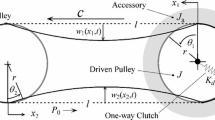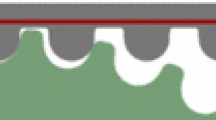Abstract
In this paper, the applicability of the absolute nodal coordinate formulation for the modeling of belt-drive systems is studied. A successful and effective analyzing method for belt-drive systems requires the exact modeling of the rigid body inertia during an arbitrary rigid body motion, accounting of shear deformation, description of highly nonlinear deformations, and a simple as well as realistic description of the contact. The absolute nodal coordinate formulation meets the challenge and is a promising approach for the modeling of belt-drive systems. In this study, a recently proposed two-dimensional shear deformable beam element based on the absolute nodal coordinate formulation has been modified to obtain a belt-like element. In the original element, a continuum mechanics approach is applied to the exact displacement field of the shear deformable beam. The belt-like element allows the user to control the axial and bending stiffness through the use of two parameters. In this study, the interaction between the belt and the pulleys is modeled using an elastic approach in which the contact is accounted for by the inclusion of a set of external forces that depend on the penetration between the belt and pulley. When using the absolute nodal coordinate formulation, the contact forces can be distributed over the length of the element due to the use of high-order polynomials. This is different from other approaches that are used in the modeling of belt-drives. Static and dynamic analysis are used in this study to show the performance of the distributed contact force model and the proposed belt-like element, which is able to model highly nonlinear deformations. Applying these two contributions to the modeling of belt-drive systems, instead of contact forces applied at nodes and low-order elements, leads to a considerable reduction in the degrees of freedom.
Similar content being viewed by others
References
Leamy, M. J. and Wasfy, T. M., ‘Transient and steady-state dynamic finite element modeling of belt-drives,’ Journal of Dynamic Systems, Measurement and Control 124, 2002, 575–581.
Leamy, M. J., Barber, J. R., and Perkins, N. C., ‘Distortion of a harmonic elastic wave reflected from a dry friction support,’ Journal of Applied Mechanics 65, 1998, 851–857.
Leamy, M. J., Barber, J. R., and Perkins, N. C., ‘Dynamics of belt/pulley frictional contact,’ in Proceedings of the IUTAM Symposium on Unilateral Multibody Contacts, Munich, August, Kluwer, 1998, pp. 277–286.
Leamy, M. J., The Influence of Dry Friction in the Dynamic Response of Accessory Belt Drive Systems, Doctoral Dissertation, University of Michigan, Ann Arbor, 1998.
Leamy, M. J. and Wasfy, T. M., ‘Analysis of belt-drive mechanics using a creep-rate-dependent friction law,’ Journal of Applied Mechanics 69, 2002, 763–771.
Wasfy, T. M., ‘A torsional spring-like beam element for the dynamic analysis of flexible multibody systems,’ International Journal for Numerical Methods in Engineering 39, 1996, 1079–1096.
Wasfy, T. M. and Leamy, M. J., ‘Effect of bending stiffness on the dynamic and stead-state responses of belt-drives,’ in Proceedings of the ASME 2000 Design Engineering Technical Conferences, Montreal, Canada, September 29–October 2, 2002.
Gerbert, G. G., ‘Belt slip – a unified approach,’ Journal of Mechanical Design 118, 1996, 432–438.
Shabana, A. A., Dynamics of Multibody Systems, Wiley, New York, 1998.
Shabana, A. A., ‘Computer implementation of the absolute nodal coordinate formulation for flexible multibody dynamics,’ Nonlinear Dynamics 16, 1998, 293–306.
Omar, M. A. and Shabana, A. A., ‘A two-dimensional shear deformation beam for large rotation and deformation,’ Journal of Sound and Vibration 243, 2001, 565–576.
Dufva, K., Sopanen, J., and Mikkola, A., ‘A two-dimensional shear deformable beam element based on the absolute nodal coordinate formulation,’ Journal of Sound and Vibration 280, 2005, 719–738.
Berzeri, M. and Shabana, A. A., ‘Devlopment of simple models for the elastic forces in the absolute nodal co-ordinate formulation,’ Journal of Sound and Vibration 235, 2000, 539–565.
García-Vallejo, D., Mayo, J., Escalona, J. L., and Domínguez, J., ‘Efficient evaluation of the elastic forces and the Jacobian in the absolute nodal coordinate formulation,’ Nonlinear Dynamics 35, 2004, 313–329.
Sugiyama, H. and Shabana, A. A., ‘On the use of implicit integration methods and the absolute nodal coordinate formulation in the analysis of elasto-plastic deformation problems,’ Nonlinear Dynamics 37, 2004, 245–270.
Author information
Authors and Affiliations
Corresponding author
Rights and permissions
About this article
Cite this article
Kerkkänen, K.S., García-Vallejo, D. & Mikkola, A.M. Modeling of Belt-Drives Using a Large Deformation Finite Element Formulation. Nonlinear Dyn 43, 239–256 (2006). https://doi.org/10.1007/s11071-006-7749-5
Received:
Accepted:
Issue Date:
DOI: https://doi.org/10.1007/s11071-006-7749-5




